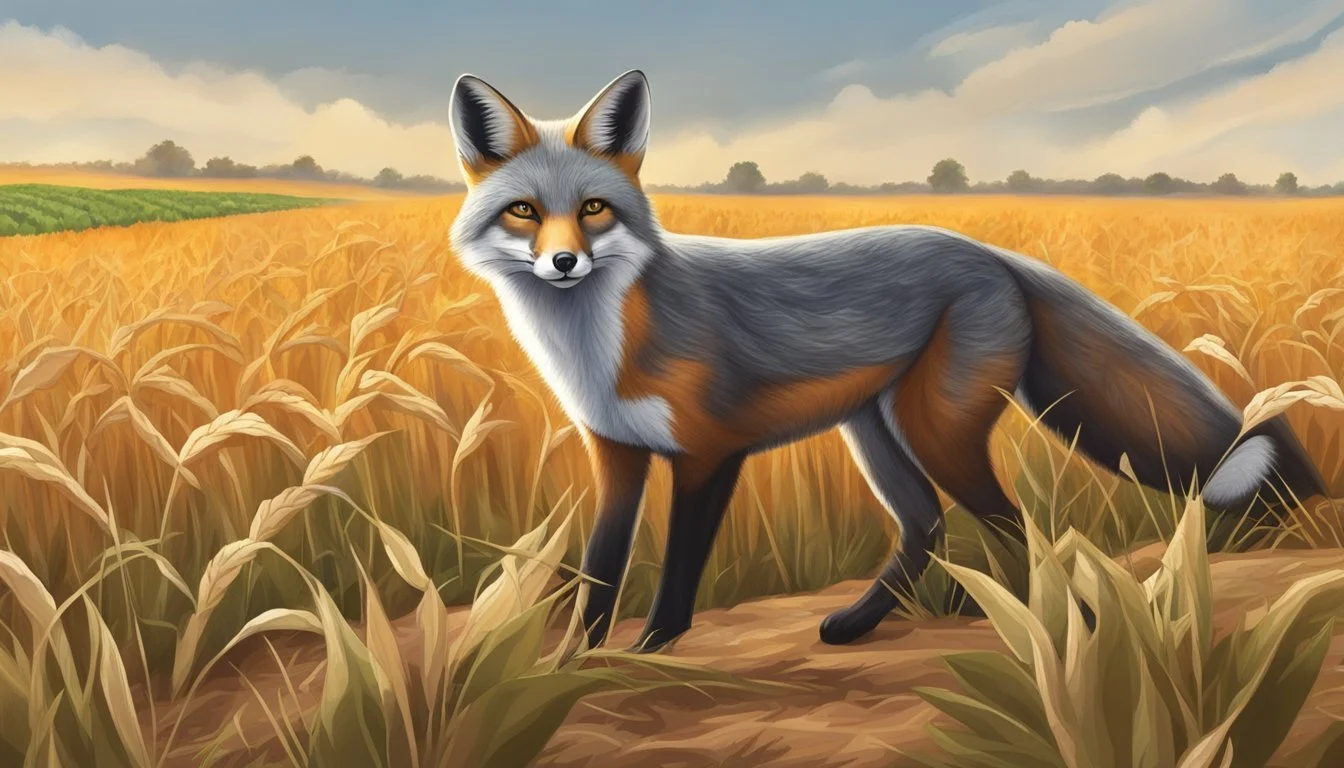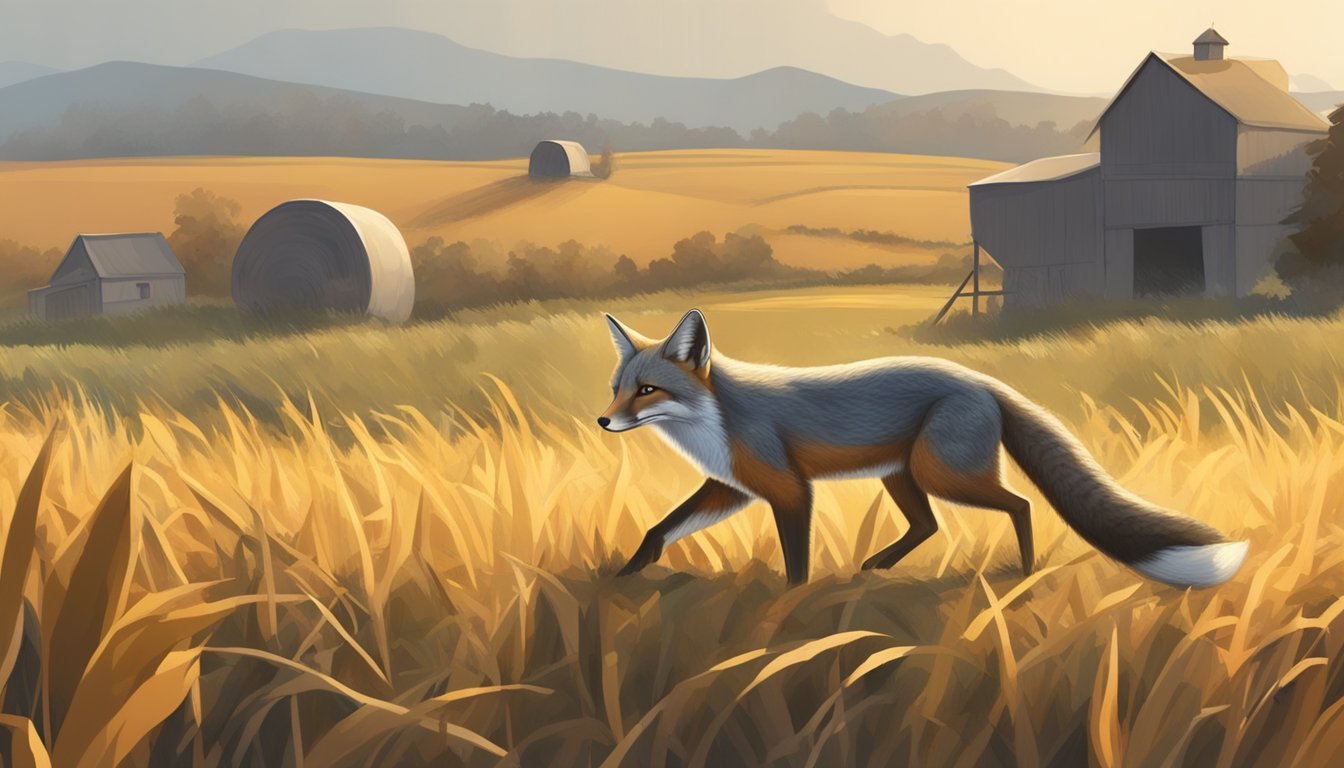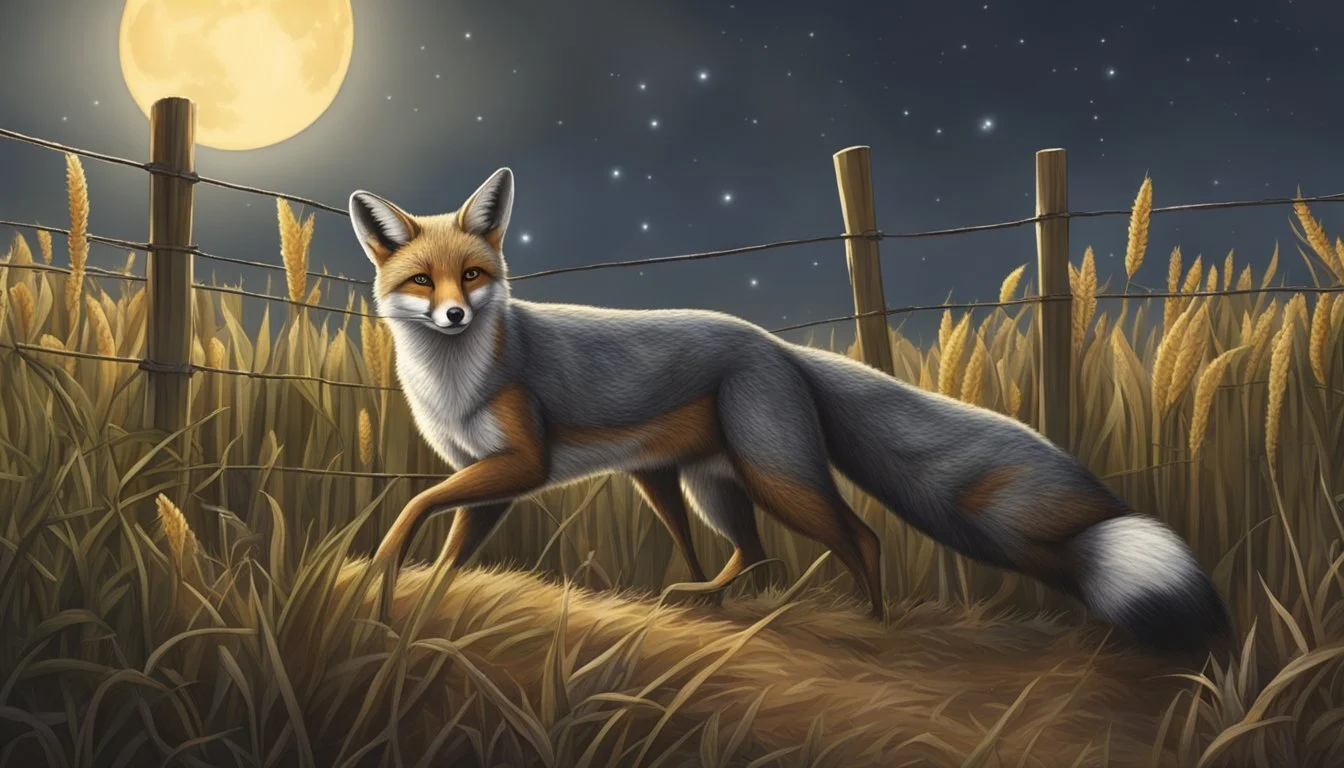Protecting Crops from Gray Fox
Effective Strategies for Farmers
Protecting crops from the invasive behaviors of the gray fox is a crucial task for many farmers and landowners. These intelligent and adaptable canines can cause significant damage to agricultural lands, feasting on fruits, vegetables, and even small livestock. Efficient and humane methods of control are essential to preserve both the livelihood of agriculturalists and the well-being of these native animals.
The challenge of managing gray fox populations effectively revolves around implementing strategies that are both effective and environmentally responsible. Traditional methods, such as fencing and the use of guard animals, have been supplemented with more contemporary approaches. This includes the utilization of motion-activated devices to deter foxes from entering crop areas. Meanwhile, habitat modification can reduce the attractiveness of the site to these animals by removing cover and food sources that they may otherwise exploit.
A key part of any strategy is understanding the behavior of the gray fox. They are primarily nocturnal and have a varied diet, which can make them persistent visitors once they have identified a food source. However, by employing a combination of physical barriers, deterrents, and landscape management, farmers can minimize the impact of gray foxes on their crops while also ensuring these creatures continue to play their role in the ecosystem.
Understanding the Gray Fox
The gray fox, Urocyon cinereoargenteus, is a solitary and somewhat secretive mammal noteworthy for its unique climbing abilities and adaptability to various ecosystems. This section aims to provide an insight into its distinguishing traits, habitat preferences, behaviors, dietary habits, and current status across territories.
Characteristics of Gray Foxes
Gray foxes exhibit a distinctive grizzled gray fur with slashes of rusty red and a black-tipped tail, earning them their name. They generally weigh between 7 to 14 pounds and measure 32 to 45 inches in length including the tail. Adapted for a semi-arboreal lifestyle, these foxes have strong, hooked claws which enable them to climb trees with ease.
Gray Fox Habitats and Ecosystems
Gray foxes are versatile in their habitat needs, inhabiting mixed landscapes that offer sufficient cover like forests, brushy fields, and rocky areas across North America. Their presence within an ecosystem often plays a crucial role in the control of small mammal populations, thereby maintaining a balanced food web.
Gray Fox Behavior and Diet
Gray foxes are primarily nocturnal creatures who adapt their diet to available food sources. Their diet usually includes a variety of rodents, insects, and birds but can also extend to fruits and plants depending on seasonal availability. Their diet flexibility aids in their survival across diverse habitats. Unique among canids, their adept climbing abilities allow them to evade predators and search for prey.
Gray Fox Populations and Distribution
The current population and distribution of gray foxes show significant variance over time and place. In Southern Illinois, a sharp decline in gray foxes was observed from the 1970s to the 2019 trapping seasons. Historically common, these reduced numbers highlight the gray fox’s fluctuating status and the need to understand their movements and ecological impacts.
Human-Wildlife Interactions
Gray foxes have become a focal point of human-wildlife interactions, particularly as their encounters with humans increase due to urban sprawl. These interactions present challenges, including issues related to crop protection, urbanization impacts, and health concerns such as rabies.
Gray Fox Encounters with Humans
Gray foxes are known for their adaptability, which has led to frequent encounters with humans. North Carolina serves as an example where the expansion of human settlements has increased the likelihood of these encounters. This has implications for both the gray foxes, which may prey on small livestock and pets, and humans, who must protect their crops and property.
Effects of Urbanization on Gray Foxes
Urbanization and the resulting increase in housing density have profound impacts on gray fox populations. They are forced to navigate environments with high anthropogenic influences, such as busy roads leading to increased roadkill, and limited natural habitats. Wildlife photos captured by experts in urban settings underscore the adaptability of gray foxes but also highlight the stresses they face in these altered landscapes.
Gray Foxes and the Threat of Rabies
A significant health concern associated with gray foxes is the threat of rabies. As opportunistic feeders, gray foxes can come into contact with rabid animals and serve as carriers. Local authorities and wildlife experts emphasize the importance of vaccinations and public awareness to manage the risk of rabies transmission to other wildlife, pets, and humans.
Gray Foxes and Crop Protection
The management of gray foxes is essential in safeguarding crops. This section details specific strategies for identifying gray fox-related damage and the use of various deterrents and technology for effective crop protection.
Identifying Gray Fox Damage
Gray foxes often leave distinct signs of their presence in gardens and crops. They can cause considerable damage to plants by digging and trampling in their search for food. Garden owners may notice disturbed soil, chewed plant stems, or even partial consumption of fruits and vegetables, indicating gray fox activity.
Non-lethal Deterrents and Repellents
To prevent foxes from damaging crops, several non-lethal methods are effective:
Sounds and Lights: Devices that produce flashing lights or sudden loud noises can deter gray foxes without causing harm.
Repellents: The use of chemical repellents can discourage gray foxes from entering a garden. These should be safe for use around plants.
Habitat Modification: Removing attractants such as fallen fruits can make an area less appealing to gray foxes.
Fencing and Other Physical Barriers
Physical barriers are a cornerstone in protecting crops from gray foxes:
Fencing: A sturdy fence that extends underground can prevent digging and entry. It should be at least 6 feet tall with a top angle outward to dissuade climbing.
Netting: For smaller garden areas, netting over plants can offer protection from gray foxes.
Role of Technology in Crop Protection from Gray Foxes
Advancements in technology provide additional solutions for mitigating gray fox damage:
Motion-Activated Devices: These devices can trigger water sprays or lights to scare away gray foxes when they approach crops.
Electronic Fencing: An electronic fence delivers a harmless but effective shock to deter gray foxes and is particularly useful in repelling non-native species that may not respond to traditional methods.
Conservation and Management to Support Coexistence
The delicate balance of conserving gray fox populations and maintaining sustainable agricultural practices necessitates targeted strategies for coexistence. These strategies are informed by the conservation status of gray foxes, their ecological impact, and the implementation of coexistence mechanisms.
Gray Fox Conservation Status
Gray fox populations are not currently listed under the Endangered Species Act, but they are an essential part of the ecosystem. Monitoring these populations, especially in forested areas of the United States like the Midwest, is crucial for maintaining biodiversity. Trappers who are managing gray fox numbers must operate within state guidelines to ensure that trapping does not adversely affect their conservation status.
Impact of Gray Fox on Ecosystems
Gray foxes play a significant role in their ecosystems as mesopredators, having a buffering effect on smaller prey species populations. They help control the populations of rodents which can be pests to crops, thus indirectly aiding agriculture. However, without effective management, gray foxes can impact ground-nesting birds and small mammals, highlighting the importance of their species roles within various states.
Strategies for Effective Coexistence of Gray Foxes and Agriculture
Agricultural lands can coexist with gray foxes by implementing non-lethal measures, which include:
Traps and relocation: Employing live traps to capture and relocate foxes to suitable forested areas away from farms.
Disease management: Vaccination programs to reduce the risk of disease transmission from foxes to humans and livestock.
Habitat alteration: Creating a natural buffer zone that encourages foxes to remain in the wild and away from crops.
Building awareness: Educating farmers and the local community about the ecological benefits of gray foxes and the importance of coexistence.
This section of coexistence methods combines respect for gray fox populations and the need for effective agricultural practice without compromising either.
Promoting Healthy Gray Fox Populations
Efforts to support robust gray fox populations focus on habitat improvements, legal safeguards, and community engagement, all aimed at sustaining these crucial carnivores within their ecosystems.
Habitat Enhancement and Green Spaces
Habitat fragmentation and loss are significant factors leading to the decline of gray fox populations. Enhancing habitats and creating green spaces provide the necessary environment for gray foxes to exhibit their instinctual actions. For example, in regions like Nevada and near Lake Tahoe, efforts to preserve natural habitats help in maintaining the ecosystems that support not only gray foxes but also other species like bears, especially during their hibernation periods. Projects within a 1-kilometer radius of critical zones can be instrumental in increasing survival rates by providing a connected and rich environment.
Regulations and Legal Protections
The Species at Risk Act (SARA) provides a framework for legal protections that help curb the decline of species like the gray fox. Setting benchmarks for conservation and implementing regulations can prevent further habitat loss. In Illinois, legal measures are in place to prevent overdevelopment, thereby preserving home ranges and habitats critical for the well-being of local carnivores, including gray foxes.
Volunteer and Community Involvement
Community engagement through volunteer efforts plays a vital role in the conservation of gray foxes. Volunteers can participate in habitat restoration projects or make use of motion-sensitive cameras to monitor gray fox movements and gather data on their home ranges and behavior. This participation enhances the collective understanding and facilitates efforts to preserve these animals' place within the ecosystem.
Understanding Predatory Behavior and Competition
In safeguarding crops from gray foxes, it is crucial to comprehend the nuances of predatory dynamics and the impact of interspecies competition. These factors dictate the presence and behavior of gray foxes within an ecosystem.
Gray Foxes vs. Other Predators
Gray foxes are known to face direct competition from various other predators for food sources such as insects, rodents, and small mammals. They share their habitats with coyotes and red foxes, both of which can influence gray fox behavior and habitat use. Interestingly, studies show that gray foxes may coexist with larger predators such as bears, which can offer an inadvertent protective effect against more aggressive species like coyotes.
In areas of coastal environments, this dynamic can be even more pronounced, with gray foxes utilizing the presence of bears to navigate the pecking order among predators. With the bear's seasonal hibernation, a temporal shift occurs, where typically avoidant species may alter their spatial patterns due to the temporary absence of a dominant predator.
Competition with Non-native Species and Its Effects
The introduction of non-native species, particularly coyotes, has exerted additional pressure on the gray fox populations. Coyotes, being larger and more versatile, often outcompete gray foxes for prey, leading to a potential decrease in gray fox numbers in some regions.
Furthermore, smaller fox species such as the kit fox and the swift fox may also be impacted by this introduction, as they engage in fear-based interactions that can disrupt their habitual behaviors. As a result, the presence of non-native competitors like coyotes can lead to significant shifts in the local ecosystems, potentially affecting the availability of food for gray foxes and thus their impact on crop predation.
Monitoring and Research
Effective monitoring and research are vital for understanding gray fox populations and developing strategies to protect crops from any potential damage they may cause. Technological advancements in camera traps and data analysis are central to these efforts.
The Role of Camera Trapping in Studying Gray Foxes
Camera traps have become an indispensable tool for wildlife researchers studying gray foxes. They are generally used to capture wildlife photos without the need for human presence. Equipped with motion-sensitive cameras, these devices provide researchers with valuable insights into the habits and population dynamics of gray foxes. For instance, analysis of camera trap data has illuminated patterns of gray fox activity and has subsequently helped in identifying the times when crops are most vulnerable to their presence.
Using Data to Inform Crop Protection Strategies
The data gleaned from camera traps, alongside reported sightings by volunteers and farmers, can greatly inform crop protection strategies. By understanding the movement and behavior of gray foxes, measures such as the timing of deterrents or the use of protective netting can be optimized. Proper data utilization leads to targeted actions that not only safeguard crops but also contribute to the well-being of gray fox populations, which have been noted to be of 'Least Concern' yet still require attention to ensure their conservation status remains stable.
Frequently Asked Questions
Effective management of gray foxes on farmland is crucial for protecting crops and livestock. This section covers questions frequently asked by farmers and property owners looking for humane and legal methods to prevent gray fox-related damage.
How can farmers deter gray foxes from their land?
Farmers can deter gray foxes by employing various techniques such as using guard animals, installing motion-activated lights or noise machines, and removing food attractants. Regularly patrolling the land, especially at dusk and dawn when gray foxes are most active, may also discourage their presence.
What measures can prevent gray foxes from predating on small domestic animals?
To prevent predation on small domestic animals, owners should secure their animals during vulnerable times, particularly at night. Sturdy enclosures with locks and secure roofing can protect pets and prevent gray fox access.
What are the effective non-lethal methods for protecting poultry from gray foxes?
Effective non-lethal methods for protecting poultry include housing them in secure coops at night, using electrified poultry netting, and installing automatic door closures. Motion-activated deterrents can also startle and ward off gray foxes without causing harm.
Which fencing types are most effective against gray fox intrusions?
Solid fences that are at least 6 feet tall with a 45-degree outward angle at the top can effectively prevent gray fox intrusions. Electric fencing is also highly effective, as it provides a deterring shock upon contact, discouraging foxes from attempting to climb or dig under.
What are the implications of local wildlife laws on managing gray fox populations?
Local wildlife laws vary significantly, but they often protect gray fox populations and restrict the methods allowed for their control. Farmers should consult with wildlife authorities to ensure compliance with regulations regarding gray fox management.
How does habitat modification help in reducing gray fox damage to crops?
Habitat modification—such as clearing brush and wood piles, securing trash bins, and managing rodents that foxes prey on—can make farmland less attractive to gray foxes. Limiting shelter and food sources can help to minimize crop damage caused by these animals.










